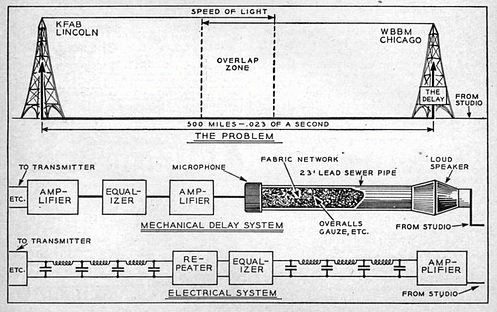In 1928, WBBM in Chicago and KFAB, then in Lincoln, Nebraska, both operated on 770 kHz with 5000 watts. And they both carried the CBS network at night. They generally coexisted well, but there was a problem for listeners, mostly in Iowa, who were equidistant from the two stations. Both stations would come in equally strong, but interfere with one another. These listeners complained to CBS, and the two stations worked at solving the problem.
Eliminating any heterodyne (the squeal caused by two signals on very close frequencies) was an easy enough problem to solve. The two stations simply needed to make sure that the transmitters were exactly on the same frequency. But there was another problem. The signals from the network came by telephone lines, and those signals travel at approximately the speed of light. Since Lincoln was 500 miles further away from New York than Chicago was, the program reached Lincoln about 23 milliseconds later than it reached Chicago. Therefore, the two stations weren’t transmitting the exact same program. KFAB was sending out the program with an additional 23 millisecond delay. (When a different phone line was used later, the delay grew to 35 milliseconds.)
This caused a problem for listeners in Iowa. The signals from Lincoln and Chicago traversed the airwaves to Iowa in the same amount of time. But since the Lincoln signals started with a built-in delay, the effect in Iowa was that the there was an echo effect when listening to CBS on 770.
The stations solved the problem in a number of ways. First of all, WBBM paid KFAB to sign off at 10:00 PM, after the end of network programs. After 10:00, WBBM had a clear channel as far west as its signal would go. The two stations also coordinated their station ID’s so that one announcer was not talking over the other. But the biggest problem to solve was the delay. To solve the problem, WBBM had to delay the network feed. With digital processing today, this would be a trivial problem to solve. But in 1928, it was a major engineering challenge.
The WBBM engineers eventually came up with an electronic solution involving 19 stages of filtering, equalization, and amplification. A series of filters, consisting of a capacitor and inductor, were carefully chosen. Each filter attenuated one frequency range, but also introduced a delay. Since they didn’t want the attenuation, the equalization was needed to restore the audio to its final form, and the amplification was needed to make up for the loss in the filters and equalizers.
But until that system was designed, WBBM engineers came up with a Rube Goldberg solution that worked amazingly well. The speed of light is about 300 million meters per second. But the speed of sound is about 1080 feet per second. To generate the necessary 23 millisecond delay, sound would need to travel about 23 feet. So the WBBM engineers procured a 23-foot section of lead sewer pipe, mounted a speaker at one end and a microphone at the other end. The sound was simply fed through the pipe before going on the air.
The system wasn’t perfect, since echos from the microphone reflected back, adding a new echo effect, what they were trying to get rid of in the first place. But this echo was solved by wadding fabric into the pipe. Close to the microphone, this consisted of gauze. Closer to the speaker, thicker material was needed. Fabric from a pair of overalls belonging to one of the staff turned out to fit the bill, and they were stuffed into the pipe.
The result was a very high quality audio signal, with a dynamic range of 100-5000 cycles. Eventually, broadcast standards called for slightly better audio, and the electronic system using filters was used. But for a time, WBBM’s programming passed through 23 feet of sewer pipe before hitting the airwaves.
References
- C.B.S. Robot Timer, Radio News, June 1938.
- Modern Mechanix, June 1939.
- WBBM Radio Yesterday and Today.
Click Here For Today’s Ripley’s Believe It Or Not Cartoon
![]()


Pingback: KFAB Lincoln, NE, 1944 | OneTubeRadio.com